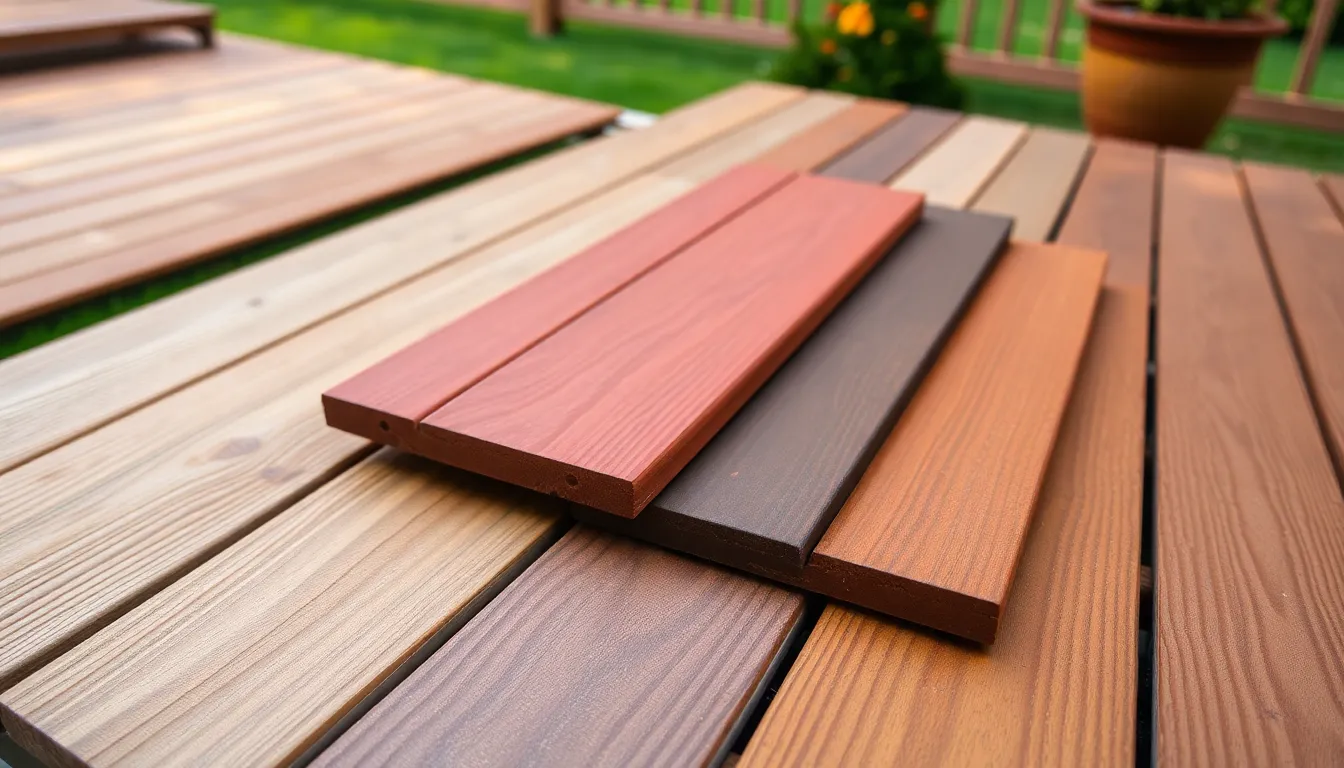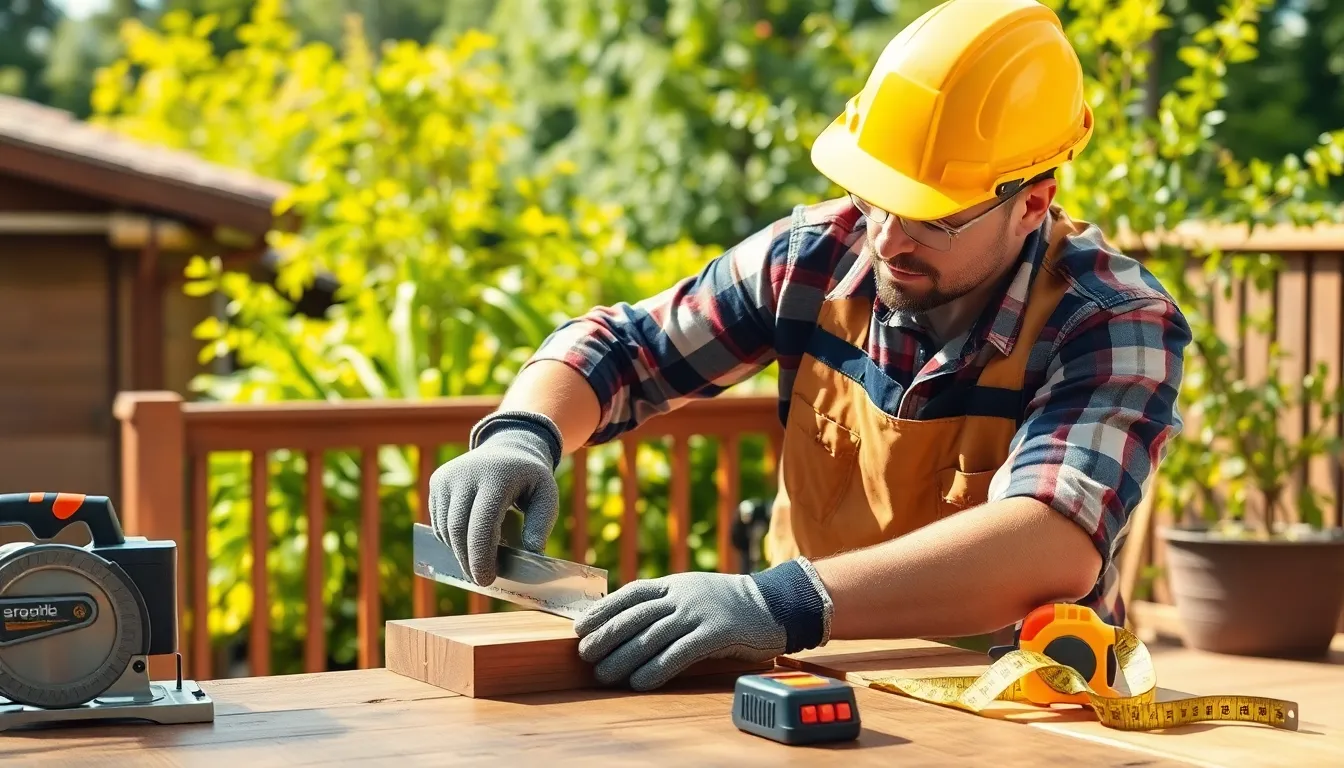Building a deck isn’t just about nailing some boards together; it’s an art form that transforms an ordinary backyard into an outdoor oasis. Picture this: lazy summer afternoons lounging with friends, sizzling barbecues, and perhaps the occasional dance party under the stars. Who wouldn’t want that? A well-constructed deck not only enhances your home’s appeal but also boosts its value.
Table of Contents
ToggleOverview of Deck Construction
Deck construction involves several critical steps that transform ideas into reality. First, selecting the right materials impacts durability and aesthetics. Common choices include pressure-treated wood, composite materials, and tropical hardwoods, with each option providing distinct advantages.
Planning and design play crucial roles. Homeowners often assess their available space, considering the deck’s size, shape, and location. Proper design can create natural flow between indoor and outdoor areas, enhancing usability.
Building permits may be necessary. Local regulations can require specific permits to ensure safety and compliance with zoning laws. Researching local building codes is essential before starting the project.
Foundation work comes next. A sturdy base supports the entire structure and can include footings, piers, or concrete slabs. Each of these foundation types provides stability and longevity.
Framing the deck follows the foundation. This process involves constructing the skeleton of the deck using joists, beams, and posts. Strong framing ensures the deck can withstand weight and weather conditions.
Decking installation occurs after framing. Various decking materials can complete the surface, providing the final look and feel. Attention to detail during this phase enhances both the appearance and safety of the deck.
Railing installation adds safety and style. Railing systems must meet building codes and provide necessary support. Different materials like wood, metal, and glass offer diverse design options to match personal preferences.
Finally, applying finishes enhances durability. Sealants, stains, or paints protect the deck against weather and wear. Regular maintenance keeps the deck looking great and extends its lifespan.
Materials Used in Deck Construction

Selecting the right materials is essential for deck construction. Each option offers distinct benefits, impacting durability, aesthetics, and maintenance.
Wood Options
Pressure-treated wood is a common choice for decking. This type of wood resists rot and insects, making it suitable for various climates. Cedar and redwood present natural beauty and resistance to decay, appealing to those who appreciate natural materials. Tropical hardwoods like mahogany and ipe provide exceptional durability. They withstand harsh weather yet require regular maintenance to preserve their appearance.
Composite Materials
Composite materials combine wood fibers and recycled plastic. This blend creates a durable product that resists fading, staining, and scratching. Often available in various colors and textures, homeowners can customize their deck. Many options mimic the look of natural wood while eliminating the need for frequent upkeep. Composite decking also limits splintering, making it safe for bare feet. Environmental factors often make this choice appealing to eco-conscious consumers.
Deck Design Considerations
Deck design involves multiple factors that affect functionality and aesthetic appeal. Homeowners must consider both layout and size to maximize the outdoor space.
Layout and Size
Layout significantly influences how the deck integrates with existing landscapes and structures. Designing the deck around natural flow allows for smooth transitions between indoor and outdoor areas. Size plays a crucial role in usability; larger decks accommodate gatherings while smaller decks suit intimate settings. Deck shapes can vary, ranging from traditional rectangles to more unique, customized designs. The chosen layout and size should reflect the homeowner’s lifestyle and intended use of the space.
Aesthetic Choices
Aesthetic choices contribute to the deck’s visual impact and complement the home’s architecture. Homeowners often select materials that harmonize with outdoor surroundings, enhancing overall appeal. Color schemes matter as well; natural wood tones create a warm, inviting atmosphere while dark materials lend a modern edge. Textures also add interest, with options like smooth finishes for a sleek look or rough textures for a rustic feel. Finally, accessories such as furniture and lighting can elevate the aesthetic, making the deck a vibrant extension of the home.
Construction Process
The construction process of a deck involves thorough planning and careful execution. Each step contributes to the overall success and durability of the finished product.
Planning and Permits
Planning a deck involves selecting the appropriate design and materials. Homeowners need to assess their outdoor space, considering factors like size and location. Obtaining necessary permits is crucial to comply with local building codes. Each municipality has specific guidelines, so consulting with local authorities can streamline this process. This preparation ensures that the project adheres to safety standards and avoids potential fines. Accurate planning reflects on the deck’s practicality and enhances its overall aesthetic.
Step-by-Step Guide
Beginning with foundation work, installing footings provides stability for the deck. Next, framing takes place, constructing a robust skeleton with posts, beams, and joists. After framing, decking installation occurs, where boards are laid for the walking surface. Following this step, railing installation enhances both safety and style, with diverse materials available. Finishing touches, such as applying sealants or stains, protect the wood from weather elements. Regular maintenance will prolong the deck’s lifespan and keep it visually appealing. This systematic approach to construction ensures a successful deck-building experience.
Maintenance and Longevity
Regular maintenance ensures a deck remains functional and visually appealing for years. Prioritizing care helps in identifying potential problems early and prolongs the lifespan of the materials used.
Routine Care
Routine care involves several key tasks. Clean the deck regularly using a broom or a stiff brush to remove debris. Inspect for signs of wear or damage after rainy days to catch issues quickly. Applying a protective sealant every couple of years increases resistance to moisture and UV rays. Staining or painting can enhance the aesthetics and provide additional protection. Consider clearing gutters and downspouts to prevent water overflow on the deck surface. These simple actions maintain beauty, prevent decay, and extend the overall life of a deck.
Repairing Common Issues
Repairing common issues keeps a deck safe and looking great. Address loose boards immediately by securing them with screws. Cracked or splintered wood requires sanding to smooth surfaces, preventing injuries. Replace warped boards promptly to maintain structural integrity. For minor stains, a mixture of soap and water can effectively remove dirt and grime. Structural problems, such as posts or beams needing reinforcement, should receive professional evaluation. Staying proactive about repairs strengthens longevity and enhances overall safety for users.
Building a deck is an investment that goes beyond mere construction. It transforms outdoor spaces into inviting areas for relaxation and social gatherings. With careful planning and the right materials homeowners can create decks that not only enhance their property’s aesthetic appeal but also boost its value.
Prioritizing maintenance ensures longevity and keeps the deck looking its best throughout the years. By addressing repairs promptly and following a regular care routine homeowners can enjoy their decks for many seasons to come. A well-constructed deck becomes a cherished part of home life offering a perfect blend of beauty and functionality.



